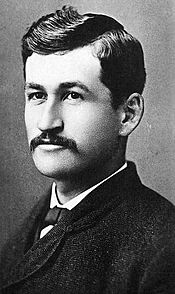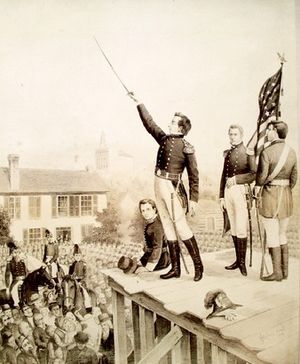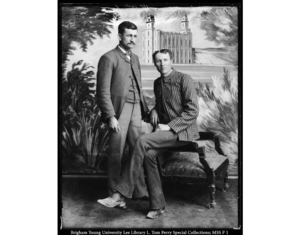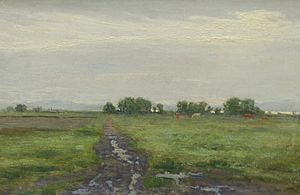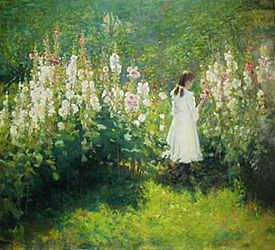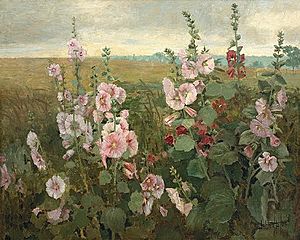John Hafen facts for kids
Quick facts for kids
John Hafen
|
|
|---|---|
| Born | 22 March 1856 |
| Died | 3 June 1910 |
| Occupation | Artist |
| Years active | 1881-1910 |
| Organization | Society of Utah Artists Utah Art Association |
|
Notable work
|
Girl Among the Hollyhocks |
| Style | Impressionism |
| Spouse(s) | Thora Twede (m. 1879) |
| Children | 10 J. Leo Hafen |
| Parent(s) | Johann Hafen Anna Elizabeth Ruesi |
| Awards | Utah Art Institute Exhibition Prize, 1893 and 1903 Utah Art Institute Medal of Honor |
John Hafen (born March 22, 1856 – died June 3, 1910) was an artist from Switzerland who moved to America. He was known for painting beautiful landscapes and portraits of people.
When John Hafen was a child, his family moved from Switzerland to the United States and settled in Utah. He showed a talent for art from a very young age. In 1890, he was chosen to be one of a group of "art missionaries." They went to study at a famous art school in Paris, France, called the Académie Julian. This trip was paid for by the Church of Jesus Christ of Latter-day Saints. The artists were preparing to paint large pictures, called murals, inside the Salt Lake Temple, which was almost finished.
After returning home, Hafen painted many scenes of Utah's countryside. He also painted portraits of important leaders of the LDS Church. John Hafen often struggled with money during his life. He didn't become widely known as an artist until a few years before he passed away. Still, he is now considered one of Utah's most important early artists. Alice Merrill Horne, a famous art critic, even called him "Utah's greatest artist."
Contents
Early Life in Utah
John Hafen was born on March 22, 1856, in Scherzingen, Switzerland. His parents, Johann Hafen and Anna Elizabeth Ruesi, had joined the Church of Jesus Christ of Latter-day Saints. John started drawing when he was very young, making sketches as early as age four.
When John was six years old, his family moved to the U.S. They traveled west in wagons, a journey that took six months from Switzerland to Utah. The Hafen family arrived in the Salt Lake Valley in 1862. Young John grew up in towns like Payson and Richfield. In Payson, he met another future artist, J. B. Fairbanks, and they became good friends.
During these years, John would "draw with bits of charcoal from the fire on anything he could find." By age eight, he knew he wanted to be an artist. When he was eleven, his mother showed his drawings to a friend. The friend was so impressed that he gave John a dollar and a half to buy real colors and drawing paper. These were the first art supplies John ever owned!
John was also very religious from a young age. After hearing a speech from Brigham Young, nine-year-old John decided to follow the Word of Wisdom, a health code for members of the LDS Church. After living in different places in Utah, the Hafen family settled in Salt Lake City in 1868. There, John began to paint more seriously.
Becoming an Artist
John Hafen went to Karl G. Maeser's 20th Ward Academy in Salt Lake City, where he took drawing classes. For the next ten years, he learned from George M. Ottinger and Dan Weggeland. These teachers were instructors at the University of Deseret, which is now the University of Utah.
His teachers wanted Hafen to travel to Europe to improve his art skills. However, the trip was too expensive. So, Hafen worked hard to become a painter in Utah. He also worked as a photographer to earn money. He started at G. R. Savage's photo studio in the 1870s. Then he worked as an assistant to George Edward Anderson, another photographer.
Hafen was able to show some of his landscape paintings at Savage's studio. A writer for the Salt Lake Herald-Republican newspaper said his paintings were "not only credible, but decidedly praiseworthy." His photographs were also praised.
In 1881, Hafen helped start the Utah Art Association with other local artists. This group organized art shows and taught new artists. The association was a place for Hafen to draw and paint for the rest of that decade.
In 1888, Hafen finished a painting called Last Public Address of Lieut. Gen. Joseph Smith. This painting showed an event that happened 44 years earlier in Nauvoo, Illinois. It was used on a poster to advertise a reunion for military veterans. Even though it might not be perfectly accurate, this painting is still a popular way to show that historical event.
During this time, Hafen also drew crayon portraits of many different people, including military leaders. Some of these were shown at Savage's studio. He continued his photography work too. He even opened a photo gallery in American Fork with his wife, Thora Twede. Even with all his hard work, Hafen found it difficult to support himself and his family with his art alone.
Studying Art in Paris
John Hafen really wanted to study art in Europe. He believed his artistic talent was a gift from God and wanted to use it to honor God. With help from George Q. Cannon, Hafen convinced the leaders of the LDS Church to pay for his art studies abroad.
At that time, there were no artists in the church who were skilled enough to decorate the Salt Lake Temple. So, the First Presidency (the church's top leaders) agreed to pay for the art mission. They provided $2160 to fund the trip. In return, the artists would use what they learned to paint the murals in the Salt Lake Temple when they came back to Utah.
On June 4, 1890, John Hafen, along with John Fairbanks, Lorus Pratt, and Edwin Evans, was called as a full-time missionary. They were assigned to Paris, France. These "French Art Missionaries" traveled east by train, stopping in New York City to visit the Metropolitan Museum of Art. Then they boarded a steamship called the Nevada to cross the Atlantic Ocean. During the trip, they taught some passengers about their faith. They also made a goal to create one sketch every day. Hafen wrote that anyone who didn't make a sketch would "be fined 10 cents." He noted that "The only fine imposed on our trip so far was Loris; one day he was so busy teaching the gospel to fellow passengers that he forgot to make a sketch."
After arriving in Paris on July 24, 1890, Hafen and Fairbanks began studying at the Académie Julian. Their main teacher was Albert Rigolot. Hafen also learned from Jules Lefebrve and Jean-Paul Laurens. The school taught them the basics of art through long classes. They spent hours sketching plaster models and other objects. This strict training helped the artists learn new painting styles. Hafen also left the city to find landscapes to sketch and paint. In the fall and winter, the artists studied indoors at the Académie. During the warmer months, they painted outdoors in the countryside with professional artists.
Hafen worked hard to meet his teachers' expectations. He tried to replace the art methods he had taught himself in Utah with these new European techniques. His personal goal was to show truth through his art. He sometimes worried about his skills and their money situation. But a letter from George Cannon encouraged him to finish his mission.
At the end of his year abroad, Hafen traveled to the countryside before leaving Europe. He sketched and painted many nature scenes. These experiences with plein air painting (painting outdoors) made him want to focus on landscapes. He improved his skills by learning from landscape artist Arthur F. Mitchell. He returned home as a landscape painter, inspired by the French Barbizon School style. George Q. Cannon offered the artists a chance to stay longer at the Académie. However, Hafen decided to stick to the original plan and come home. Hafen returned to Utah on August 17, 1891, before the other artists.
Back in Utah
John Hafen was the first of his group to start working at the Salt Lake Temple. He played a big part in planning the first murals. He painted practice pictures on canvas to get ready for the large murals. Hafen began painting on the walls of the garden room in 1892. Soon, he wrote to the other art missionaries, asking them to return and help paint the murals. He then had help from Fairbanks, Pratt, Evans, and his old teacher, Weggeland. Working together, the team finished the garden and world room murals in time for the temple's opening.
Hafen continued to paint after returning home. He opened his own art studio in Springville. There, he showed his paintings of the Utah countryside from the mid-1890s until 1907. In 1893, he won the Utah Art Institute Exhibition prize of $300. That same year, he became the vice president of the Society of Utah Artists. His paintings were shown at the group's 1896 exhibit. He was called "one of the best portrait artists in the west." In 1899, he won third prize in the Utah Art Institute competition for his painting called North Fork Provo Canyon.
After his time in Paris, Hafen missed being so close to the art world. This desire to work among other artists, along with his ongoing money problems, made Hafen want to leave Utah again. In 1900, he decided to travel to the coast. He went first to Seattle and then to Pacific Grove, California. In Seattle, he met artists who were less skilled but more successful at selling their art. In Pacific Grove, he completed fifteen paintings and six drawings in just 26 days. Some of these were landscapes of the ocean. He reportedly "became enamored with painting the sea." However, he didn't get the money or connections he hoped for, so Hafen returned to Utah.
Still in debt, Hafen asked the LDS Church for financial help. In 1901, he signed a contract with President Lorenzo Snow. He agreed to paint a certain number of landscapes and portraits each month in return for $100. Some of these portraits showed LDS General Authorities (church leaders) and were "accepted as being satisfactory" by the church. With this support and income, Hafen was able to travel again. His lifelong friend John Fairbanks went with him to New York and Boston. But misfortune followed him east, and he again returned home without the recognition he wanted. Over the years, Hafen painted about 200 works for the church. This included Girl Among the Hollyhocks, which is considered "a masterpiece of American Impressionism."
When he returned to Utah, Hafen had some small successes. For example, Heber J. Grant bought one of his paintings for $250. In 1903, after attending an art lecture at Brigham Young Academy, Hafen decided to donate his painting called Mountain Stream to Springville High School. He wanted to inspire a new generation of artists in that community. He also won the Utah Art Institute prize again that year.
Later Years and Success
Still struggling with money, Hafen moved to Illinois in 1908. Soon, his paintings were shown in an exhibit at Marshall Field's Gallery in Chicago. Here, he finally started to get some of the recognition he had been looking for his whole life.
He then moved to Nashville, Indiana. There, he began working on a series of eight paintings to go with Eliza R. Snow's poem "O, My Father." The sixth painting in this series is special because it's the earliest known artwork by a Latter-day Saint artist to show Heavenly Mother. He used his family members and local LDS Church leaders as models for these paintings.
Hafen was upset when the LDS Church seemed unwilling to support his booklet of poems and paintings for missionaries. He thought they didn't like his art. Church leaders explained that they enjoyed the paintings, but they were worried about salespeople using a church endorsement to pressure members into buying the booklet. The booklet was later published and sold by Hafen's friends and family. He finished these paintings the year before he died.
Along with Adolph Shultz, Hafen became involved in the growth of the Brown County Art Colony. He left to visit his family in Utah for a while. Then he returned to Indiana with his son Virgil, who also wanted to be an artist. Together, they opened an art studio in Indianapolis. Hafen began to sell more of his paintings and received more requests for his work. This included painting a portrait of Governor Thomas R. Marshall. He was awarded the Utah Art Institute Medal of Honor and first prize at the 1908 Illinois State Fair for his landscape paintings. However, his success was short-lived, as he passed away in 1910.
Personal Life
John Hafen met his wife, Thora Twede, at George Edward Anderson's photography studio. They got married on June 13, 1879, in the Salt Lake City Endowment House. Their son, J. Leo Hafen, was born the next year, on May 23.
Hafen found it hard to balance his art with the need to earn money for his family. He tried many different ways to make money, but none of them worked out well. By 1890, Hafen and Thora had five children. According to one of their sons, they had a happy marriage. Thora supported his artistic dreams, and both were very dedicated to their religion. William Conant Jr. said, "His driving force was faith in God and the surety that his calling in life was to paint."
During his trip to Europe, Hafen spent a few weeks in his home country of Switzerland. He continued to improve his art skills there. He also tried, but didn't succeed, in finding his family roots. He was deeply inspired by his time in Paris and admired the city's love for art. But he missed his wife and children throughout his time as an art missionary.
After Hafen returned to the U.S., Thora gave birth to three more children: Alma in 1892, Joseph in 1895, and Frederic in 1898. Their family eventually grew to include 10 children. The money problems he had before his trip to France continued when he returned to Utah. Hafen combined his art and church commissions with other jobs, just as he had done before. One writer described it this way: "extreme poverty was Hafen's almost constant companion in life." He fought against it the best he could with his artistic spirit.
Even though he was too poor to pay his rent, Hafen found a way to get a home in Springville. He traded a painting for the right to use some land. He also bartered with local people for help with building. The house was a Swiss-style chalet, designed by his friend Alberto Treganza. It was built in 1900 and is now listed in the National Register of Historic Places as the "John Hafen House". Hafen painted a mural of hollyhocks flowers to cover a plain wall in the house.
Hafen was separated from his family during his trips to the west coast and to the east. He sent money to his wife and children whenever he could. His finances got better during his last few years in Indiana, and he was able to make ends meet. Thora and the children moved to Indianapolis to be with him. Sadly, he passed away just five weeks after they arrived.
Death and Legacy
John Hafen died of pneumonia in Indianapolis on June 3, 1910. He was 56 years old. His body was brought back to Utah and buried in a Springville cemetery. This was a place where he had, years before, painted a picture looking across his beloved valley towards the mountains. His funeral was held on June 9 in the Provo Tabernacle. Speakers included George H. Brimhall and B. H. Roberts. Roberts remembered that Hafen saw art as his life's mission and "was willing to sacrifice all" for his creative pursuits.
Hafen believed that art should show truth, especially about religion. This strong belief made it hard for him to appeal to everyone and become famous. Even though he didn't achieve widespread success during his life, art critic Alice Merrill Horne called Hafen the best painter of his time. His paintings became very popular among art collectors in Utah. Many of his works are now part of the collection at the Museum of Church History and Art.
Hafen's donation of Mountain Stream to Springville High School started an art education effort. This effort eventually grew into the Springville Museum of Art. His paintings have been shown in Paris, Boston, Chicago, Philadelphia, and St. Louis at various art exhibitions. The John Herron Art Institute has also featured his works.


